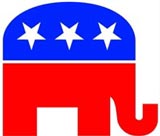Thomas Nast created the Democratic donkey. The donkey was first associated with Democrat Andrew Jackson's 1828 presidential campaign. His opponents called him a jackass (a donkey), and Jackson decided to use the image of the strong-willed animal on his campaign posters. Later, Thomas used the Democratic donkey in newspaper cartoons, making the symbol famous.
Nast also created the Republican elephant. In a cartoon that appeared in Harper's Weekly in 1874, Nast drew a donkey dressed in lion's skin, scaring away all the other animals at the zoo. One of those animals, was labeled "The Republican Vote." From that point forward, the elephant became associated with the Republican Party.
Thomas Nast denounced Tammany as a ferocious tiger killing democracy
Tammany Hall was a New York political organization founded in 1786 and incorporated in 1789 as the Tammany Society. It was a Democratic Party political machine that played a major role in New York City politics, helping mostly the Irish rise up in American politics in the 1790s to the 1960s. The society is known for its corruption, and while it rose up and down in political influence, it was without a doubt one of the most powerful organizations in early political America.
"Who stole the people's money?" by Thomas Nast
Political cartoons, while seemingly harmless, yielded great influence over public opinion. Reportedly, Tweed didn't care what the papers said about him, he just wanted Thomas Nast, the cartoonist from Harper's Weekly to stop drawing "them damned pictures."








No comments:
Post a Comment